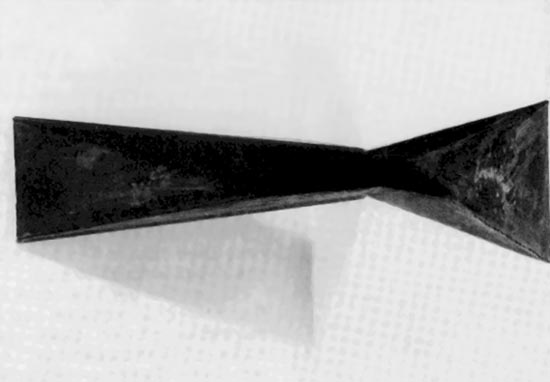
Joseph Zito at Rosa Esman
October 1988 · by Walter Thompson

In a very direct and physical way, Joseph Zito’s sculptures interact with the wall space against which they are seen. Their welded steel parts are assembled into narrow, troughlike shapes which are then partially buried in the gallery walls, making dark and mysterious crevices. Some of these channel forms are duplicated in lead or wax and attached, in a reverse format, to the imbedded sections. Thus, the upper half of Endless Void is a narrow steel gutter with staggered depths, mounted vertically and flush with the wall. Hanging off the bottom edge and projecting outward is a wax copy of the wall element which presents its solid side to the viewer.
In Grand and Lexington, the open metal section installed in the wall is stubbier and mounted closer to the floor. Two wax clones have been cast from the implanted unit, and are attached to the wall component and to each other, end to end, creating a three–part configuration that stretches out into the gallery space at floor level. Other works in the show do not employ the casting method, and at least one of them is not wall–mounted.
A distinct variation in format is Monroe, a horizontal piece made up of a pair of long, but unequal, triangular shapes in dark steel with raised sides. Welded together, tip to tip, at their narrowest points, they produce a shape approximating a thin bow tie. Each steel face is angled slightly inward so that the whole fits kina skewed fashion into a corner of the gallery; an unsettling tension is created with the walls behind the piece. The effect is augmented in a fascinating way by the lighting; shadows cast by the sculpture meet precisely at the juncture of the abutting walls, so that while the piece itself not align with the corner of the gallery, its shadows do.
Zito’s exhibition included several drawings in black and white oil paint that were developed as monoprints from wooden blocks. The repetition of forms also occurs in these drawings. Take For Max, in which a large geometric shape is duplicated—flipped over and reversed. This young artist’s concept of replication is as effective in two dimensions as it is in three. And in his ideas of intrusion and protrusion, Zito has a basis for making sculpture that is equally advanced and promising.